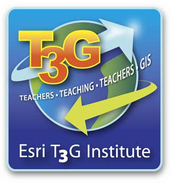Beautiful, Interactive Maps for the Classroom (Now with GIS Analysis!)
Well, it’s a week since I left the ESRI Teachers Teaching Teachers GIS (T3G) Conference held at ESRI in Redlands, CA. After a week of being completely distracted by another amazing conference, I now can revisit my T3G reflections and share some of my takeaways.
Full GIS Analysis in the Cloud Brings GIS to the Masses
The end of ArcGIS Desktop in the classroom?
First of all, what I keep coming back to is something that was not so much said, but more of an understanding that I have determined. This past week I witnessed not just points on a map in ArcGIS Online, but real GIS analysis. ESRI is putting some of it’s most popular and useful analysis tools into the cloud. I’ll say it one more time. GIS analysis in the cloud. Not only that, this is the model they are pushing for educators to use.
What does this mean?
What they are doing with ArcGIS Online is bringing full GIS, with analysis, to the cloud, and to the students. This means no software to install (no IT guy to get approval from). This means processing on a server (not local). This means simpler interface (web based, it has to be). This means simpler access to data (datasets preloaded and findable in the cloud). So, major hurdles of software access, complex GUI, high powered PC, and data converting erased.
Overall, I think ArcGIS Online has the potential to revolutionize mapping in education.
Tools For Prettifying Maps
The new ESRI map offerings don’t suck.
Two things struck me this week. The maps I was looking at all week, whether being a collection displayed as a Map Gallery, A Web Mapping Application, or a Storymap, didn’t suck. This is a big deal. We all love the pretty stamen/mapbox basemaps (am I right?). This week, I was looking at maps from ESRI that were, do I dare say it, beautiful. That’s exciting and transformative. They are maps WORTH sharing, not just data being presented online. I know that this will make students happy, because when they create a map, they will then be excited to share it. While this may seem like a small deal, this is a HUGE deal.
These are also things that I want to bring back to Skidmore College and implement. I would love to have a Map Gallery highlighting student interactive maps. I have already begun exploring the use of Storymaps in the classroom and for campus initiatives (here’s our simple graffiti prototype.) Getting ArcGIS Online into our GIS class is essential, but I think it is just the beginning. With analysis in the cloud, and beautiful online map output, I think it will grow quickly on campus, especially as we ramp up some of our on campus outreach to departments.
So, to sum it up, I think these pretty maps will go a long way in helping to spread the map love on campus, and in education.
Learning Pathways
Getting started with mapping in education.
Well, I did a lot of time reflecting about teaching professional development this week. After all, it was an institute on how to teach teachers GIS. Something I have alway thought about is meeting people where they are, and starting simple. For instance, if you start to high up the pyramid, you may lose people who don’t have some of the basics. There was a great graphic illustrating this for teaching GIS. Here it is.
This we used all week as a model for reflection as we did different activities. It was very useful for the conscious awareness of why and how we were doing what we were doing. Instructors prompted “what level of the pyramid are you working in now?” and we would respond. I really liked this aspect of the workshop.
Related to this concept I must tell a quick story. First of all, I am so thankful for meeting many of the wonderful Geographic Alliance coordinators at this institute. It was so refreshing to see this commitment to geography education by truly inspiring individuals.
In reflecting on my interactions with these folks, I investigated some great entry level mapping resources. I found the National Geographic MapMaker Interactive a great entry level tool for inspiring geographic exploration and simple maps. Additionally, I thought that Fieldscope was a fascinating citizen science project.
Finally, I reflected on what some of my Skidmore professor’s actually use a lot. Microsoft Excel. One of my sessions highighted something that I might be able to show some of my Excel-expert faculty called ESRI Maps for Office (EMO, for short). EMO allows you to go from tabular data to interactive map in Powerpoint in very little time. I was impressed with this tool, and this might be a good GIS-light application for those with heavy Excel experience.
So, to summarize, I became aware of entry level mapping tools that show great promise, and could be excellent for starting students, teachers, or faculty.
So, how do I wrap all this all up? Cloud mapping for education is here, and the maps look great. Think about how you teach, and don’t be afraid to scaffold with some of the great National Geographic mapping resources and ESRI Maps for Office.
That’s my takeaway. Thanks to Adena for the prompt to write this.



Alex great job on your reflections. It is funny because I am presenting the same reflection from my experience next week during the Delaware Digital Learning Conference. Your bloggers must appreciate the speed of your communications.
Best, Brooke T3G13